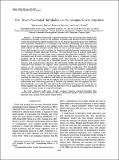Por favor, use este identificador para citar o enlazar a este item:
http://hdl.handle.net/10261/94686COMPARTIR / EXPORTAR:
 SHARE SHARE
 CORE
BASE CORE
BASE
|
|
| Visualizar otros formatos: MARC | Dublin Core | RDF | ORE | MODS | METS | DIDL | DATACITE | |

| Título: | Fire drives functional thresholds on the savanna-forest transition |
Autor: | Dantas, Vinícius de L.; Batalha, M. A.; Pausas, J. G. CSIC ORCID | Palabras clave: | Savanna-forest systems Plant functional traits Plant-fire feedback Physiognomic gradient Phylogenetic diversity Fire regimes Brazil Emas National Park Ecological thresholds Community dynamics Cerrado Alternative stable states Tropical biomes |
Fecha de publicación: | 2013 | Editor: | Ecological Society of America | Citación: | Ecology 94: 2454-2463 (2013) | Resumen: | In tropical landscapes, vegetation patches with contrasting tree densities are distributed as mosaics. However, the locations of patches and densities of trees within them cannot be predicted by climate models alone. It has been proposed that plant-fire feedbacks drive functional thresholds at a landscape scale, thereby maintaining open (savanna) and closed (forest) communities as two distinct stable states. However, there is little rigorous field evidence for this threshold model. Here we aim to provide support for such a model from a field perspective and to analyze the functional and phylogenetic consequences of fire in a Brazilian savanna landscape (Cerrado). We hypothesize that, in tropical landscapes, savanna and forest are two stable states maintained by plant-fire feedbacks. If so, their functional and diversity attributes should change abruptly along a community closure gradient. We set 98 plots along a gradient from open savanna to closed forest in the Brazilian Cerrado and tested for a threshold pattern in nine functional traits, five soil features, and seven diversity indicators. We then tested whether the threshold pattern was associated with different fire regimes. Most community attributes presented a threshold pattern on the savanna-forest transition with coinciding breakpoints. The thresholds separated two community states: (1) open environments with low-diversity communities growing in poor soils and dominated by plants that are highly resistant to high-intensity fires; and (2) closed environments with highly diverse plant communities growing in more fertile soils and dominated by shade-tolerant species that efficiently prevent light from reaching the understory. In addition, each state was associated with contrasting fire regimes. Our results are consistent with the hypothesis that forests and savannas are two coexisting stable states with contrasting patterns of function and diversity that are regulated by fire- plant feedbacks; our results also shed light on the mechanism driving each state. Overall, our results support the idea that fire plays an important role in regulating the distribution of savanna and forest biomes in tropical landscapes. © 2013 by the Ecological Society of America. | Versión del editor: | https://doi.org/10.1890/12-1629.1 | URI: | http://hdl.handle.net/10261/94686 | DOI: | 10.1890/12-1629.1 | Identificadores: | issn: 0012-9658 |
| Aparece en las colecciones: | (CIDE) Artículos |
Ficheros en este ítem:
| Fichero | Descripción | Tamaño | Formato | |
|---|---|---|---|---|
| Dantas-2013-Ecology_savanna-forest-threshold.pdf | 186,15 kB | Adobe PDF |  Visualizar/Abrir |
CORE Recommender
SCOPUSTM
Citations
155
checked on 20-abr-2024
WEB OF SCIENCETM
Citations
149
checked on 26-feb-2024
Page view(s)
303
checked on 24-abr-2024
Download(s)
652
checked on 24-abr-2024
Google ScholarTM
Check
Altmetric
Altmetric
NOTA: Los ítems de Digital.CSIC están protegidos por copyright, con todos los derechos reservados, a menos que se indique lo contrario.
